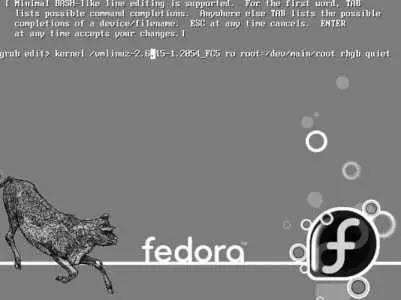Figure 10-22. Modified splash image

10.5.1.3. Creating additional boot entries
Creating additional boot entries is simply a matter of entering additional lines with the options that you want.
For example, you could create two separate entries for Fedora Coreone for runlevel 5 (GUI) and one for runlevel 3 (text mode):
title Fedora Core - Graphical Login ( 2.6.31-1.3420_fc6 )
root (hd0,1)
kernel /vmlinuz- 2.6.31-1.3420_fc6 ro root=/dev/main/root rhgb quiet
initrd /initrd- 2.6.31-1.3420_fc6 .img
title Fedora Core - Text Login ( 2.6.31-1.3420_fc6 )
root (hd0,1)
kernel /vmlinuz- 2.6.31-1.3420_fc6 ro root=/dev/main/root rhgb quiet 3
initrd /initrd- 2.6.31-1.3420_fc6 .img
These two options are identical except for the descriptions on the title lines and the addition of the number 3 to the end of the kernel line for text-mode entry.
Installing a new kernel RPM will add an additional boot option and make it the default. If you are using yum to perform updating, a maximum of two versions of the kernel will be installed at once (configurable in /etc/yum/pluginconf.d/installonlyn.conf ), so old kernel versions and their corresponding GRUB entries may be removed from the menu by yum when updating.
10.5.1.4. Installing GRUB's boot record from Fedora
Anaconda normally installs the GRUB boot record on the first disk drive automatically.
There are two situations where it may be necessary to manually install GRUB on an existing system:
When you're using a RAID 1 /boot partition, Anaconda will install the Grub boot record only on the first disk drive. Having a mirrored copy of /boot won't help if the first disk drive fails and you can't boot from the second drivea situation easily remedied by installing the GRUB boot record on the second drive as well.
When your boot record is corrupted or overwritten by another program, such as an installer for another operating system, you may need to manually install the GRUB boot record again.
The easiest way to install GRUB is to use the grub-install script:
# grub-install --root-directory= /boot /dev/hda
Installation finished. No error reported.
This is the contents of the device map /boot/boot/grub/device.map.
Check if this is correct or not. If any of the lines is incorrect,
fix it and re-run the script \Qgrub-install'.
(fd0) /dev/fd0
(hd0) /dev/hda
(hd1) /dev/hdb
(hd2) /dev/hdc
(hd3) /dev/sdb
The --root-directory argument specifies the root directory for the boot files and should be used only if /boot is a mount point for a separate boot partition. The drive argument at the end of the line ( /dev/hda ) specifies the hard drive that GRUB will be installed on.
grub-install uses Linux disk names, such as /dev/hdc , instead of Grub disk names such as (hd2).
10.5.1.5. Installing GRUB's boot record from a GRUB DVD or floppy disk
Sometimes the GRUB boot record gets damaged, making it impossible to boot the system normally. It may be necessary to boot from a GRUB DVD or floppy disk to fix this type of problem.
To create a GRUB DVD on a Fedora system (obviously not the one that won't boot!), enter these commands:
# cd /usr/share/grub/
# growisofs -Z /dev/cdrom -R -b stage2_eltorito -no-emul-boot -boot-load-size 4 -boot-info-table i386-redhat
Type the entire growisofs command on one continuous line.
To create a bootable floppy instead of a DVD:
# cd /usr/share/grub/i386-redhat
# cat stage1 stage2 >/dev/fd0
It's worthwhile keeping a GRUB DVD or floppy with your system manuals just in case you ever find that you can't boot your system due to bootloader problems.
Boot your system with this disc or floppy. A GRUB command prompt will appear, as shown in Figure 10-23 .
Figure 10-23. GRUB command prompt from a CD/DVD boot

At this prompt, search for your stage1 file:
grub> find /boot/grub/stage1
Error 15: File not found
grub> find /grub/stage1
(hd0,0)
If your boot files are in your root filesystem, GRUB will find /boot/grub/stage1 , but if you have a separate /boot partition, GRUB will find /grub/stage1 . In the previous example, the partition (hd0,0) contains the stage1 file.
Make this partition your root partition:
grub> root (hd0,0)
Filesystem type is ext2fs, partition type 0x83
Now instruct GRUB to set up the boot record on that drive:
grub> setup (hd0)
Checking if "/boot/grub/stage1" exists... no
Checking if "/grub/stage1" exists... yes
Checking if "/grub/stage2" exists... yes
Checking if "/grub/e2fs_stage1_5" exists... yes
Running "embed /grub/e2fs_stage1_5 (hd0)"... 15 sectors are embedded.
succeeded
Running "install /grub/stage1 (hd0) (hd0)1+15 p (hd0,0)/grub/stage2 /grub/grub
.conf"... succeeded.
Done
Note that the setup command was given the drive (hd0) instead of the partition (hd0,0) to install the boot record at the start of the drive instead of the start of the boot partition.
You can now remove the GRUB disc/floppy and boot directly from the hard drive.
10.5.1.6. Editing boot options
To temporarily override a GRUB menu option, select a menu option on the boot menu using the up/down arrow keys, and then press E (for edit). The screen shown in Figure 10-24 will be displayed.
If you have a bootloader password configured, you will be prompted for it at this point.
Figure 10-24. Selecting a menu-entry line to edit

Use the arrow keys to select the line you wish to edit, and then press E again. You can now move across the line using the arrow keys, as shown in Figure 10-25 . Type new text to insert it into the line, or use the Backspace/Delete keys to remove text. Press Enter when done.
Figure 10-25. Edit a line in a menu entry

Press Enter to accept your changes or Esc to undo them. In either case you will return to the menu-entry display shown in Figure 10-24 ; press B to boot, or press Esc to return to the boot menu.
Читать дальше
















